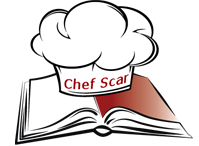(Serves four)
Ingredients:
- 3/4 cup + 6 tbsps. of extra virgin olive oil
- 8 large cloves of garlic, sliced thin + 5 large cloves garlic, chopped fine
- 1 tbsp. + 1 tsp. of hot red pepper flakes (omit the tablespoon if not all are seafood lovers, see below)
- 2 cans (35 oz.) San Marzano Tomatoes, drained (reserve liquid) and cut-up into large chunks
- 1-pound dried Linguine (Barilla, DeCecco or other premium brand)
- 25 to 30 (6-8 per person) Extra Large Shrimp (16/20 to pound size)
- ½ cup dry white wine
- 1 cup of San Marzano tomato liquid (only if sauce is too thick for taste)
- 30 leaves of fresh Basil
Preparation:
These steps can be performed in advance
1. Peel and devein the Shrimp, cover and keep refrigerated until ready to cook
2. Bring large pot of water to boil, for the Linguine
3. Heat 3/4 cup of extra virgin olive oil in a large frying pan
4. When oil is hot, but not smoking, stir in the sliced garlic and sauté until it begins to turn a dark almond color; quickly remove the sliced garlic with a slotted spoon before it begins to burn and discard it.
5. Shut heat, and add 1 tablespoon of hot red pepper flakes, wait 10 seconds to allow the pepper flakes to brown lightly. (This step can be skipped for those who want plain marinara sauce.)
6. Add cut-up and drained San Marzano Tomatoes, turn heat to high and bring to a boil. Stir well and frequently to blend oil and tomatoes; reduce, or shut heat, if not yet ready for the next phase. (Note: It is not necessary to cook for more than 10 minutes, once the sauce begins to bubble)
About 15 minutes before you are ready to serve the Linguine
1. Heat remaining 6 tablespoons of extra virgin olive oil in a large frying pan
2. Add a few drops of olive oil to the boiling water, place the dried linguine in boiling water and follow pasta cooking instructions on the box, approximately 9 minutes
3. Add 5 cloves of chopped garlic to the hot oil in the pan
4. When garlic turns very light golden color, shut the heat, add 1 teaspoon of hot red pepper flakes, wait about 10 seconds.
5. Add shrimp and turn flame to high. Sauté and periodically turn the shrimp for 3 minutes, add white wine and continue cooking 2 minutes more, until gray color is completely gone and shrimp are pink throughout.
6. If using the San Marzano tomato liquid, add about 1 cup or less to the shrimp when they are cooked, stir well to heat the liquid and add all to the previously cooked sauce. (If serving both marinara and Fra Diavolo, leave shrimp to side until sauce is added to pasta)
7. When the linguine is cooked, drain it and toss it well with the sauce.
8. Tear basil leaves into small pieces and add to the Linguine with Shrimp, Fra Diavolo, toss well again and serve.
Hot crusty Italian Bread makes a great accompaniment, as does a good Chianti. While some think that it is anathema to serve grated cheese with seafood, I do not subscribe to that philosophy and believe that this dish benefits from some freshly grated Pecorino – Romano cheese sprinkled over the pasta. If you wish to make this dish for more than 4 people, add one more can of tomatoes, one more pound of linguine and additional shrimp as necessary; the quantity of the other ingredients can remain as above.







